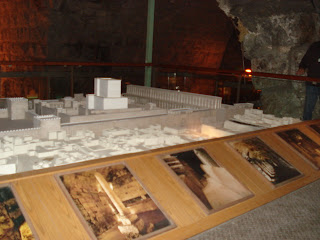Every Sunday, I've been watching THE BIBLE on History channel, a film produced by Roma Downey and Mark Burnett. I noticed in the Exodus part of the film the "Pillar of Fire" was absent while the pharaoh and his soldiers were pursuing Moses and his people. And when Jesus was born, in the film, it was raining very hard when according to common religious story it was midnight clear, the shepherds were in the field, and the Bethlehem Star was shining brightly.
 |
| Entrance to the Western Wall Heritage - By reservation only |
In the year 70 A.D., Judaea was besieged by General Vespasian and his army. He was recalled to Rome and became emperor. Roman forces led by his son Titus destroyed Jerusalem and the Second Temple. The city and the temple were laid to waste. The First Revolt (66 - 70 A.D.), the defenders of Jerusalem - the Zealots - were totally defeated. The temple was heaved over the sides of the Temple Mount - not to be excavated until 2,000 years later. During the prolonged siege and numerous battles of 70 A.D., hundreds of thousands were starved and killed outright by Roman soldiers. Thousands more were sold to slavery. Titus was anxious to show his father, now Emperor Vespasian, his complete victory and set sail for Rome. He sailed with thousands of prisoners, about 20,000, including high-ranking Jewish leaders and Jewish General Josephus who defected to the Romans. Titus also sailed with all the captured Temple treasures to celebrate his victory. In Rome, Titus was awarded a Triumph - a civil ceremony and religious rite to honor Roman army generals. According to Josephus, who became Vespasian's court historian, there was a spectacular parade at the Roman Forum of statues and very tall floats, over four stories in some, with Temple treasures piled high. The treasures included the sacred Menorah candelabra, the golden Shewbread table, and the silver trumpets of Israel and Jericho. Behind the treasure rode Vespasian, dressed in purple robe and followed by Titus and his brother Domitian. Jewish captives were displayed as part of the parade, with rope encircling the neck of military leader and star prisoner Simon ben Giora. The whole thing was recorded as one of the grandest celebrations in the history of the Roman Empire.
What ever happened to these Second Temple treasures? In 455 A.D., after the sacking of Rome by the Vandals, they carried the booty to their capital Carthage in Africa. The Byzantine historian Procopius says the treasure was captured anew by General Belisarius in 533 and carried through the street of Constantinople, capital of eastern Roman Empire, in another triumphal procession. This meant it was carried through both Roman capitals, about 500 years apart. Oh! The glory that was Rome.
 |
| The Temple Mount continues to be the focus of prayer for Jews from all over the world |
 |
| Herodian Masonry |
 |
| Passage way to the cistern |
 |
| Cistern under the Temple Mount - source of water from up above the Temple Mount
|
Part of the Colosseum was destroyed by earthquakes.
 |
| Arch of Constantine 315 A.D. |
 |
| Arch of Titus 82 A.D. |
Published 3/22/13 lib's labyrinth
Web Page: America Israel Tour








No comments:
Post a Comment